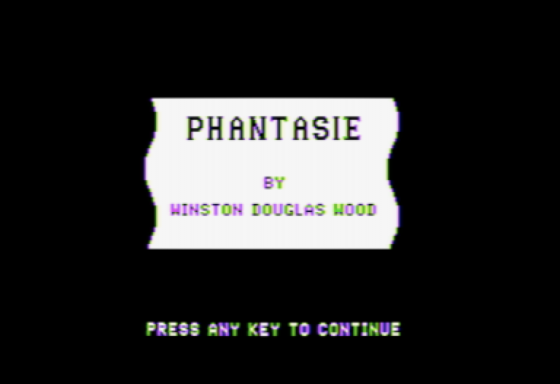
C&VG
 1st October 1986
1st October 1986
Publisher: Strategic Simulations Inc
Machine: Apple II
Published in Computer & Video Games #60
Phantasie
Phantasie is a D&D type game, in which the adventurer gathers a party of adventurers around him, and goes off to explore the Isle of Gelnor.
His objective is to defeat the dreaded Black Knights, and to destroy the evil sorceror Nikademus.
There are a number of towns on the island, and the player starts off in Pelnor. In each town, there are five places to visit - the Guild, Bank, Mystic, Armoury and Inn.
The Guild is where a party is gathered, and since you won't get very far on your own, this must be your first call.
Once inside, you have a choice of recruiting a number of the residents, from a range of fighters, monks, priests, rangers, thieves and wizards.
Each character will be a member of a particular species, from human through halfling to elf. You can add your own characters to this list, and then select the mix you want to accompany you.
At the bank, members of the group can withdraw the funds necessary for weaponry and for overnight accommodation.
There is a wide range of weapons available at the armoury, and so, bristling to the teeth with maces, clubs, spells and shields, the bold adventurers set forth on their exploration.
The countryside of Gelnor is populated with a fearsome collection of monsters of all types, and likely the party will be attacked.
Fleeing is an option sometimes successful, but winning a battle will give survivors of the fight more experience points, and - booty - the treasures carried by the monsters.
Play is controlled by joystick throughout, the only exception to this rule is when you wish to enter the name of newly created characters from the keyboard.
The joystick is used to select either text or graphic icons. The way this is implemented is very slick, and makes what might otherwise be a difficult game to play very simple.
The screen is generally laid out with a largish window bottom left. Adding members to your party, is achieved by selecting ADD from a text list on the right hand side, which then causes the window to fill with a list of all the characters, and their current status; i.e. whether they are OK and available.
The joystick now drives a highlight up and down this list, scrolling the list itself when the window boundary is met. Pressing the button adds a member to the party, who is then listed above the window.
Control passes to a Yes/No icon on the right, asking whether more members are required.
A master menu on the right offers the option of moving, or alternatively you can inspect any member of the party, use a potion, or cast a spell.
Inspection of a character brings up a whole screenful of information to him, relating to his possessions, attributes, age, experience and hit points.
Selecting MOVE brings up four direction icons, and holding the joystick to cover the required word, continues moving the party in discrete steps, at an easily controllable pace.
An encounter with monsters will more often than not end up with a fight. The options to flee, fight, beg for mercy, greet or threaten are selectable on the right of the screen. To the top, the party is listed, with a colour highlight to denote who is active, sleeping or dead, together with his hit points.
Having decided to fight, control passes to the member list of active fighters, and their modes are all set to "parry". To the right is a list of tactics, such as lunge, thrust, slash, and selecting a character allows his tactic to be changed.
To commence battle, "carry on fighting" is selected, and a graphic screen fills the window, with a commentary given at the top.
The battle, complete with sound effects, is quite dramatic. After each "round", the cycle re-commences so that the tactics can be changed.
If the game sounds complex, don't worry. It can be played on a simple level to start with, after no more than a few minutes perusing the glossy 32-page instruction manual.
After playing for a while to get the hang of things, you'll probably want to read the manual in a bit more depth, to better control the course of events.
And the manual has depth, just as the game. There are detailed tables of hit-points, spells, and magic points, by class and level of adventurer, and lists of spells weapons, armour and shields.
The manual is written for the Apple version, but there is a Commodore 64 appendix.
All in all, this is quite the best game of its type that I have seen.


